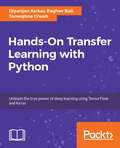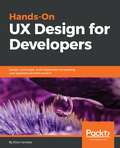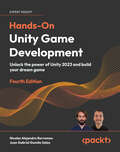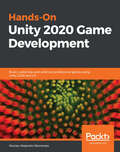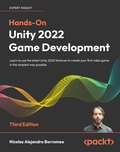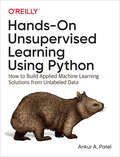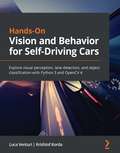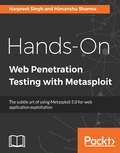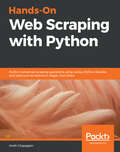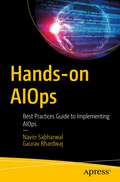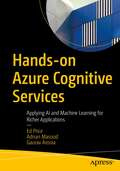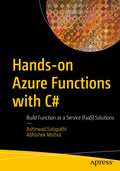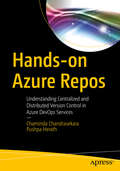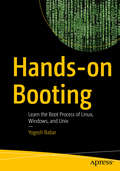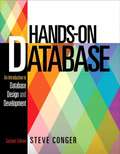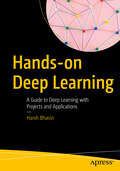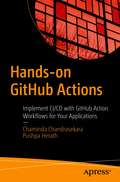- Table View
- List View
Hands-On Transfer Learning with Python: Implement advanced deep learning and neural network models using TensorFlow and Keras
by Raghav Bali Dipanjan Sarkar Tamoghna GhoshDeep learning simplified by taking supervised, unsupervised, and reinforcement learning to the next level using the Python ecosystemKey FeaturesBuild deep learning models with transfer learning principles in Pythonimplement transfer learning to solve real-world research problemsPerform complex operations such as image captioning neural style transferBook DescriptionTransfer learning is a machine learning (ML) technique where knowledge gained during training a set of problems can be used to solve other similar problems. The purpose of this book is two-fold; firstly, we focus on detailed coverage of deep learning (DL) and transfer learning, comparing and contrasting the two with easy-to-follow concepts and examples. The second area of focus is real-world examples and research problems using TensorFlow, Keras, and the Python ecosystem with hands-on examples. The book starts with the key essential concepts of ML and DL, followed by depiction and coverage of important DL architectures such as convolutional neural networks (CNNs), deep neural networks (DNNs), recurrent neural networks (RNNs), long short-term memory (LSTM), and capsule networks. Our focus then shifts to transfer learning concepts, such as model freezing, fine-tuning, pre-trained models including VGG, inception, ResNet, and how these systems perform better than DL models with practical examples. In the concluding chapters, we will focus on a multitude of real-world case studies and problems associated with areas such as computer vision, audio analysis and natural language processing (NLP).By the end of this book, you will be able to implement both DL and transfer learning principles in your own systems.What you will learnSet up your own DL environment with graphics processing unit (GPU) and Cloud support Delve into transfer learning principles with ML and DL modelsExplore various DL architectures, including CNN, LSTM, and capsule networks Learn about data and network representation and loss functionsGet to grips with models and strategies in transfer learning Walk through potential challenges in building complex transfer learning models from scratch Explore real-world research problems related to computer vision and audio analysis Understand how transfer learning can be leveraged in NLPWho this book is forHands-On Transfer Learning with Python is for data scientists, machine learning engineers, analysts and developers with an interest in data and applying state-of-the-art transfer learning methodologies to solve tough real-world problems. Basic proficiency in machine learning and Python is required.
Hands-On TypeScript for C# and .NET Core Developers: Transition from C# to TypeScript 3.1 and build applications with ASP.NET Core 2
by Francesco AbbruzzeseDiscover how TypeScript allows you to build modern client-rich applications, thanks to its object-oriented capabilities and third-party tools like Angular and Web APIsKey FeaturesMake a seamless transition to using TypeScript 3.1 in your development stackWork with TypeScript 3.1 in your ASP.NET Core projects to build rich applications that are easy to maintainBuild, test, and integrate your own TypeScript library in real-world projectsBook DescriptionWriting clean, object-oriented code in JavaScript gets trickier and complex as the size of the project grows. This is where Typescript comes into the picture; it lets you write pure object-oriented code with ease, giving it the upper hand over JavaScript. This book introduces you to basic TypeScript concepts by gradually modifying standard JavaScript code, which makes learning TypeScript easy for C# ASP.NET developers.As you progress through the chapters, you'll cover object programming concepts, such as classes, interfaces, and generics, and understand how they are related to, and similar in, both ES6 and C#. You will also learn how to use bundlers like WebPack to package your code and other resources. The book explains all concepts using practical examples of ASP.NET Core projects, and reusable TypeScript libraries. Finally, you'll explore the features that TypeScript inherits from either ES6 or C#, or both of them, such as Symbols, Iterables, Promises, and Decorators.By the end of the book, you'll be able to apply all TypeScript concepts to understand the Angular framework better, and you'll have become comfortable with the way in which modules, components, and services are defined and used in Angular. You'll also have gained a good understanding of all the features included in the Angular/ASP.NET Core Visual Studio project template.What you will learnOrganize, test, and package large TypeScript code baseAdd TypeScript to projects using TypeScript declaration filesPerform DOM manipulation with TypeScriptDevelop Angular projects with the Visual Studio Angular project templateDefine and use inheritance, abstract classes, and methodsLeverage TypeScript-type compatibility rulesUse WebPack to bundle JavaScript and other resources such as CSS to improve performanceBuild custom directives and attributes, and learn about animationsWho this book is forIf you’re a C# or .NET developer looking for an easy accessible way of learning TypeScript, this book is for you.
Hands-On UX Design for Developers: Design, prototype, and implement compelling user experiences from scratch.
by Elvis CanzibaLearn every step you need for product design and developmentKey FeaturesExplore all the tools that you need to be a complete UX designerCode the product designs you’ve created to become a full-stack designerBuild an amazing portfolio with real-world projectsBook DescriptionDesigning user experience (UX) is one of the most important aspects of a project, as it has a direct effect on how customers think of your company. The process of designing a user experience is one of the most challenging yet rewarding aspects of product development. Hands-On UX Design for Developers will teach you how to create amazing user experiences for products from scratch.This book starts with helping you understand the importance of a good UX design and the role of a UX designer. It will take you through the different stages of designing a UX and the application of various principles of psychology in UX design. Next, you will learn how to conduct user research and market research, which is crucial to creating a great UX. You will also learn how to create user personas and use it for testing. This book will help you gain the ability to think like a UX designer and understand both sides of product development: design and coding. You will explore the latest tools, such as Sketch, Balsamiq, and Framer.js, to create wireframes and prototypes. The concluding chapters will take you through designing your UI, dealing with big data while designing a UX, and the fundamentals of frontend. Finally, you'll prepare your portfolio and become job ready in the UX arena.What you will learnWhat UX is and what a UX designer doesExplore the UX Process and science of making products user-friendlyCreate user interfaces and learn which tools to useUnderstand how your design works in the real worldCreate UI interaction, animation, wireframes, and prototypesDesign a product with users in mindDevelop a personal portfolio and be well-prepared to join the UX worldWho this book is forHands-On UX/UI Design for Developers is for web designers who have knowledge of basic UX design principles.
Hands-On Unity Game Development: Unlock the power of Unity 2023 and build your dream game
by Nicolas Alejandro Borromeo Juan Gabriel SalasUnlock game development mastery with Unity 2023! This book takes you from conception to publication, equipping you with the key tools and techniques you need to bring your gaming vision to life.Key FeaturesLearn the fundamentals of Unity 2023 and create your dream gameExplore the world of augmented reality (AR) to create captivating mobile gamesPropel game performance and player experience to new heights with Data-Oriented Technology Stack (DOTS) insightsBook DescriptionTake your game development skills to the next level. Dive into the world of game creation confidently by elevating your game development skills. This book is your definitive and practical guide to unlocking the full potential of Unity 2023. Every chapter is designed to empower you to customize your own game, not just replicate what's in the book. This new edition includes immersive Augmented Reality (AR) experiences and performance optimization with Data-Oriented Technology Stack (DOTS). From Scene Creation to seamless Assert Integration, dive into C# programming and Visual Scripting with step-by-step guidance for beginners. Implement dynamic gameplay elements, including movement, spawning, physics, and health systems. Delve deeper into the magic of Game AI through sensor-driven decision-making with Finite State Machines (FSMs). Elevate your visuals with materials, shaders, textures, and particle systems. Optimize performance with Profiler insights and debug your game for a polished final product. Whether you're a beginner or a seasoned pro, this book will equip you with the skills needed to bring your game ideas to life.What you will learnBuild a game that includes gameplay, player and non-player characters, assets, animations, and moreLearn C# and Visual Scripting to customize player movements, the UI, and game physicsImplement Game AI to build a fully functional enemy capable of detecting and attackingUse Universal Render Pipeline (URP) to create high-quality visuals with UnityCreate win-lose conditions using design patterns such as Singleton and Event ListenersImplement realistic and dynamic physics simulations with the new Physics SystemWho this book is forBoth game and non-game developers looking to migrate or start building 3D games in Unity will find this Unity game development book useful. While you can still follow along without prior programming experience, knowing C# fundamentals will help you make the most of this book.
Hands-On Unity 2020 Game Development: Build, customize, and optimize professional games using Unity 2020 and C#
by Nicolas Alejandro BorromeoBuild immersive game experiences using the new Unity 2020 features with this practical guide Key Features Unleash the capabilities of C# scripting for creating immersive UI, graphics, Game AI agents and much more Explore Unity's latest tools, including Universal Render Pipeline, Shader Graph, and VFX graph, to enhance graphics and animation Get started with building augmented reality experience using Unity's AR Foundation Book Description Over the years, the Unity game engine has extended its scope from just being about creating video games to building AR/VR experiences, complex simulations, real-time realistic rendering, films, and serious games for training and education. Its features for implementing gameplay, graphics, and customization using C# programming make Unity a comprehensive platform for developing professional-level, rich experiences. With this book, you'll be able to build impressive Unity projects in a step-by-step manner and apply your knowledge of Unity concepts to create a real-world game. Complete with hands-on tutorials and projects, this easy-to-follow guide will show you how to develop your first complete game using a variety of Unity tools. As you make progress, you'll learn how to make the most of the Unity Editor and create scripts using the C# programming language. This Unity game development book will then take you through integrating graphics, sound, and animations and manipulating physics to create impressive mechanics for your games. You'll also learn how to code a simple AI agent to challenge the user and use profiling tools to ensure that the code runs in a performant way. Finally, you'll get to grips with Unity's AR Foundation for creating AR experiences for 3D apps and games. By the end of this book, you'll have developed a complete game and will have built a solid foundation using Unity's tooling ecosystem to develop game projects of any scale. What you will learn Write scripts for customizing various aspects of a game, such as physics, gameplay, and UI Program rich shaders and effects using Unity's new Shader Graph and Universal Render Pipeline Implement postprocessing to increase graphics quality with full-screen effects Create rich particle systems for your Unity games from scratch using VFX Graph and Shuriken Add animations to your game using the Animator, Cinemachine, and Timeline Implement game artificial intelligence (AI) to control character behavior Detect and fix optimization issues using profilers and batching Who this book is for This book is for game developers looking to migrate to the Unity game engine. If you are a developer with some exposure to Unity, this book will help you explore its latest features. Prior experience with C# programming is required to get the most out of the book.
Hands-On Unity 2021 Game Development: Create, customize, and optimize your own professional games from scratch with Unity 2021, 2nd Edition
by Nicolas Alejandro BorromeoAchieve mesmerizing game experiences using the latest Unity 2021 features by following a practical approach to building professional gamesKey FeaturesUnleash the capabilities of C# scripting to create UIs, graphics, game AI agents and moreExplore Unity's latest tools, including Universal Render Pipeline, Shader Graph, UI Toolkit, Visual Scripting, and VFX graph, to enhance graphics and animationBuild an AR experience using Unity's AR FoundationBook DescriptionUnity is a comprehensive yet simple suite of tools for developing video games. You can use Unity to not only create video games, but also AR/VR experiences, complex simulations, real-time realistic rendering, films, and practical games for training and education. With this book, you will get to grips with creating a full game from the ground up, building it step-by-step and applying your knowledge as you progress. Complete with hands-on tutorials and projects, this easy-to-follow guide will teach you how to develop the game using several Unity tools. As you advance, you will learn how to use the Unity engine, create simple scripts using C#, integrate graphics, sound, and animations, and manipulate physics to create interesting mechanics for your game. You'll be able to apply all the knowledge that you gain to a real-world game. Later chapters will show you how to code a simple AI agent to challenge the user and use profiling tools to ensure that the code runs efficiently. Finally, you'll work with Unity's AR tools to create AR experiences for 3D apps and games. By the end of this Unity book, you will have created a complete game and built a solid foundation in using a wide variety of Unity tools.What you will learnExplore both C# and Visual Scripting tools to customize various aspects of a game, such as physics, gameplay, and the UIProgram rich shaders and effects using Unity's new Shader Graph and Universal Render PipelineImplement postprocessing to improve graphics quality with full-screen effectsCreate rich particle systems for your Unity games from scratch using VFX Graph and ShurikenAdd animations to your game using the Animator, Cinemachine, and TimelineUse the brand new UI Toolkit package to create user interfacesImplement game AI to control character behaviorWho this book is forThis Unity engine book is for game developers looking to migrate to the Unity game engine. If you are a developer with some exposure to Unity, this book will help you explore its latest features. Prior experience with C# programming is required to get the most out of this Unity game development book.
Hands-On Unity 2022 Game Development: Learn to use the latest Unity 2022 features to create your first video game in the simplest way possible, 3rd Edition
by Nicolas Alejandro BorromeoCreate, customize, and optimize your own professional games from scratch with Unity 2022Includes invitation to join the online Unity Game Development community to read the book alongside Unity developers/C# programmers and Nicolas Borromeo.Purchase of the print or Kindle book includes a free eBook in the PDF format.Key FeaturesCreate the game prototype and learn the fundamentals of Unity editor to build scenes, objects and import objectsAdd interactivity, win/lose conditions, sound, graphics and artificial intelligence using C# and visual scriptingImprove the game graphics, user interface, add visual effects and animations using Animator, Cinemachine, and TimelineBook DescriptionUnity is a cross-platform game engine that provides you with powerful but simple-to-use features to solve the most common problems in Game Development, such as rendering, animation, physics, sound, and effects. You'll learn to use these features to create simple but complete games (and all the nuances needed to handle Unity).Complete with hands-on tutorials and projects, this book will teach you to use the Unity game engine, create C# and visual scripts, integrate graphics, sound, and animations, and manipulate physics to create interesting mechanics for your game. You'll then code a simple AI agent to challenge the user and work with profiling tools to ensure code efficiency.Finally, you'll work with Unity's AR tools to create AR experiences for 3D apps and games before publishing them to the world.If you are interested in creating impressive, commercial-quality games that are playable on a variety of platforms, then you've come to the right place.What you will learnBuild a game prototype that includes gameplay, player and non-player characters, assets, animations, and moreSet up and navigate the game engine to dive into the Unity Editor and discover unique and new features released in 2022Learn both C# and Visual Scripting to customize player movements, the user interface, and game physicsApply shaders to improve your game graphics using Shader Graph and Universal Render Pipeline (URP)Create win-lose conditions for the game by using design patterns such as Singleton and Event ListenersImplement Game AI to build a fully functional enemy capable of detecting and attacking the playerDebug, test, optimize, and create an executable version of the game to share with your friendsWho this book is forBoth game and non-game developers who wish to migrate or start building 3D games in Unity will find this book useful. While you'll still able to follow along if you don't have any programming experience, knowing the fundamentals of C# programming will help you get the most out of this book.
Hands-On Unsupervised Learning Using Python: How to Build Applied Machine Learning Solutions from Unlabeled Data
by Ankur A. PatelMany industry experts consider unsupervised learning the next frontier in artificial intelligence, one that may hold the key to general artificial intelligence. Since the majority of the world's data is unlabeled, conventional supervised learning cannot be applied. Unsupervised learning, on the other hand, can be applied to unlabeled datasets to discover meaningful patterns buried deep in the data, patterns that may be near impossible for humans to uncover.Author Ankur Patel shows you how to apply unsupervised learning using two simple, production-ready Python frameworks: Scikit-learn and TensorFlow using Keras. With code and hands-on examples, data scientists will identify difficult-to-find patterns in data and gain deeper business insight, detect anomalies, perform automatic feature engineering and selection, and generate synthetic datasets. All you need is programming and some machine learning experience to get started.Compare the strengths and weaknesses of the different machine learning approaches: supervised, unsupervised, and reinforcement learningSet up and manage machine learning projects end-to-endBuild an anomaly detection system to catch credit card fraudClusters users into distinct and homogeneous groupsPerform semisupervised learningDevelop movie recommender systems using restricted Boltzmann machinesGenerate synthetic images using generative adversarial networks
Hands-On Unsupervised Learning with Python: Implement Machine Learning And Deep Learning Models Using Scikit-learn, Tensorflow, And More
by Giuseppe BonaccorsoThis book is intended for statisticians, data scientists, machine learning developers, and deep learning practitioners who want to build smart applications by implementing key building block - unsupervised learning. Get well versed with all the new techniques and algorithms offered in machine learning and deep learning using real-world examples. Having some knowledge of machine learning concepts, and statistics will definitely help.
Hands-On Vision and Behavior for Self-Driving Cars: Explore visual perception, lane detection, and object classification with Python 3 and OpenCV 4
by Luca Venturi Krishtof KordaThis book is for software engineers who are interested in learning about technologies that drive the autonomous car revolution. Although basic knowledge of computer vision and Python programming is required, prior knowledge of advanced deep learning and how to use sensors (lidar) is not needed.
Hands-On Visual Studio 2022: A developer's guide to exploring new features and best practices in VS2022 for maximum productivity
by Miguel Angel Garcia Hector Uriel RojasLearn to design, develop, debug, and deploy technologies by harnessing the full power of Visual Studio 2022 by discovering its new features and exclusive techniquesKey FeaturesDiscover solutions to common problems faced while using Visual Studio 2022Explore tips, tricks, and best practices and discover ways to overcome source-code challengesDeep dive into Visual Studio's new features and unleash its potential to enhance your coding journeyBook DescriptionVisual Studio 2022 is the complete and ideal integrated development environment (IDE) for creating large, complex, and scalable applications. It is one of the most complete tools available for development, especially with Microsoft technologies. This book will teach you how to take advantage of the tools available with this IDE to write clean code faster. You'll begin by learning how to set up and start Visual Studio 2022 and how to use all the tools provided by this IDE. You will then explore key combinations, tips, and additional utilities that can help you to code faster and review your code constantly. Next, you will see how to compile, debug, and inspect your project to analyze its current behavior using Visual Studio. The book also shows you how to insert reusable blocks of code writing simple statements. Later, you will learn about visual aids and artificial intelligence that will help you improve productivity and understand what is going on in the project. By the end of this book, you will be able to set up your development environment using Visual Studio 2022, personalize the tools and layout, and use shortcuts and extensions to improve your productivity.What you will learnUnderstand what's new in Visual Studio 2022Discover the various code tools to improve productivityExplore the benefits of using .NET 6 in Visual Studio 2022Perform compilation, debugging, and version control comfortablyBecome well-versed with various shortcuts, tricks, tips, and tools to improve productivity within Visual Studio 2022Implement remote and collaborative work with Visual Studio 2022Who this book is forThis book is for .NET software developers focusing on web development and web developers who want to learn about the new features, tools, and features available in Visual Studio 2022. Basic knowledge of HTML, CSS, and JavaScript or frameworks such as React and Angular is assumed.
Hands-On Web Penetration Testing with Metasploit: The subtle art of using Metasploit 5.0 for web application exploitation
by Harpreet Singh Himanshu SharmaIdentify, exploit, and test web application security with ease Key Features Get up to speed with Metasploit and discover how to use it for pentesting Understand how to exploit and protect your web environment effectively Learn how an exploit works and what causes vulnerabilities Book Description Metasploit has been a crucial security tool for many years. However, there are only a few modules that Metasploit has made available to the public for pentesting web applications. In this book, you'll explore another aspect of the framework – web applications – which is not commonly used. You'll also discover how Metasploit, when used with its inbuilt GUI, simplifies web application penetration testing. The book starts by focusing on the Metasploit setup, along with covering the life cycle of the penetration testing process. Then, you will explore Metasploit terminology and the web GUI, which is available in the Metasploit Community Edition. Next, the book will take you through pentesting popular content management systems such as Drupal, WordPress, and Joomla, which will also include studying the latest CVEs and understanding the root cause of vulnerability in detail. Later, you'll gain insights into the vulnerability assessment and exploitation of technological platforms such as JBoss, Jenkins, and Tomcat. Finally, you'll learn how to fuzz web applications to find logical security vulnerabilities using third-party tools. By the end of this book, you'll have a solid understanding of how to exploit and validate vulnerabilities by working with various tools and techniques. What you will learn Get up to speed with setting up and installing the Metasploit framework Gain first-hand experience of the Metasploit web interface Use Metasploit for web-application reconnaissance Understand how to pentest various content management systems Pentest platforms such as JBoss, Tomcat, and Jenkins Become well-versed with fuzzing web applications Write and automate penetration testing reports Who this book is for This book is for web security analysts, bug bounty hunters, security professionals, or any stakeholder in the security sector who wants to delve into web application security testing. Professionals who are not experts with command line tools or Kali Linux and prefer Metasploit's graphical user interface (GUI) will also find this book useful. No experience with Metasploit is required, but basic knowledge of Linux and web application pentesting will be helpful.
Hands-On Web Scraping with Python: Perform advanced scraping operations using various Python libraries and tools such as Selenium, Regex, and others
by Anish ChapagainCollect and scrape different complexities of data from the modern Web using the latest tools, best practices, and techniques Key Features Learn various scraping techniques using a range of Python libraries such as Scrapy and Beautiful Soup Build scrapers and crawlers to extract relevant information from the web Automate web scraping operations to bridge the accuracy gap and ease complex business needs Book Description Web scraping is an essential technique used in many organizations to scrape valuable data from web pages. This book will enable you to delve deeply into web scraping techniques and methodologies. This book will introduce you to the fundamental concepts of web scraping techniques and how they can be applied to multiple sets of web pages. We'll use powerful libraries from the Python ecosystem—such as Scrapy, lxml, pyquery, bs4, and others—to carry out web scraping operations. We will take an in-depth look at essential tasks to carry out simple to intermediate scraping operations such as identifying information from web pages, using patterns or attributes to retrieve information, and others. This book adopts a practical approach to web scraping concepts and tools, guiding you through a series of use cases and showing you how to use the best tools and techniques to efficiently scrape web pages. This book also covers the use of other popular web scraping tools, such as Selenium, Regex, and web-based APIs. By the end of this book, you will have learned how to efficiently scrape the web using different techniques with Python and other popular tools. What you will learn Analyze data and Information from web pages Learn how to use browser-based developer tools from the scraping perspective Use XPath and CSS selectors to identify and explore markup elements Learn to handle and manage cookies Explore advanced concepts in handling HTML forms and processing logins Optimize web securities, data storage, and API use to scrape data Use Regex with Python to extract data Deal with complex web entities by using Selenium to find and extract data Who this book is for This book is for Python programmers, data analysts, web scraping newbies, and anyone who wants to learn how to perform web scraping from scratch. If you want to begin your journey in applying web scraping techniques to a range of web pages, then this book is what you need! A working knowledge of the Python programming language is expected.
Hands-on AIOps: Best Practices Guide to Implementing AIOps
by Navin Sabharwal Gaurav BhardwajWelcome to your hands-on guide to artificial intelligence for IT operations (AIOps). This book provides in-depth coverage, including operations and technical aspects. The fundamentals of machine learning (ML) and artificial intelligence (AI) that form the core of AIOps are explained as well as the implementation of multiple AIOps uses cases using ML algorithms.The book begins with an overview of AIOps, covering its relevance and benefits in the current IT operations landscape. The authors discuss the evolution of AIOps, its architecture, technologies, AIOps challenges, and various practical use cases to efficiently implement AIOps and continuously improve it. The book provides detailed guidance on the role of AIOps in site reliability engineering (SRE) and DevOps models and explains how AIOps enables key SRE principles. The book provides ready-to-use best practices for implementing AIOps in an enterprise. Each component of AIOps and ML using Python code and templates is explained and shows how ML can be used to deliver AIOps use cases for IT operations.What You Will Learn Know what AIOps is and the technologies involved Understand AIOps relevance through use cases Understand AIOps enablement in SRE and DevOps Understand AI and ML technologies and algorithmsUse algorithms to implement AIOps use casesUse best practices and processes to set up AIOps practices in an enterprise Know the fundamentals of ML and deep learning Study a hands-on use case on de-duplication in AIOps Use regression techniques for automated baseliningUse anomaly detection techniques in AIOps Who This Book is For AIOps enthusiasts, monitoring and management consultants, observability engineers, site reliability engineers, infrastructure architects, cloud monitoring consultants, service management experts, DevOps architects, DevOps engineers, and DevSecOps experts
Hands-on Azure Boards: Configuring and Customizing Process Workflows in Azure DevOps Services
by Chaminda Chandrasekara Pushpa HerathUnderstand and explore the features and management of Azure Boards with this book, which also covers Azure Boards configuration and advanced administration. This book starts by setting up projects with Azure DevOps and gives an overview of Azure Boards and its features. You will then learn to set up team projects and how to effectively use Azure Boards to plan and execute work. Hands-on Azure Boards explains customizations, where you will understand the available options to track your work considering different scenarios. Next, you will learn visualizing with queries, charts, and dashboards along with reporting of Azure Boards. The author gives you hands-on lessons to set up Azure Boards and shows you how to handle multiple modules that are taken care of by different teams. You will also explore the security options in Azure Boards as well as a detailed demonstration of working with the REST API and CLI. Finally, you will work with useful extensions for Azure Boards and see how to use them more effectively and efficiently. After reading this book, you will be able to work with the Azure Boards capabilities available in Azure DevOps on-premise server and services to improve your software delivery process. What You Will LearnPlan and manage work with Azure BoardsUse the REST API and command line interface with Azure BoardsExtend Azure Boards with useful extensions to enhance its capabilities Customize Azure Boards to adapt it to your processReport and visualize work progress with Azure BoardsWho This Book Is ForAnyone working in Azure DevOps developing applications targeting any platform using any language.
Hands-on Azure Cognitive Services: Applying AI and Machine Learning for Richer Applications
by Adnan Masood Ed Price Gaurav AroraaUse this hands-on guide book to learn and explore cognitive APIs developed by Microsoft and provided with the Azure platform. This book gets you started working with Azure Cognitive Services. You will not only become familiar with Cognitive Services APIs for applications, but you will also be exposed to methods to make your applications intelligent for deployment in businesses.The book starts with the basic concepts of Azure Cognitive Services and takes you through its features and capabilities. You then learn how to work inside the Azure Marketplace for Bot Services, Cognitive Services, and Machine Learning. You will be shown how to build an application to analyze images and videos, and you will gain insight on natural language processing (NLP). Speech Services and Decision Services are discussed along with a preview of Anomaly Detector. You will go through Bing Search APIs and learn how to deploy and host services by using containers. And you will learn how to use Azure Machine Learning and create bots for COVID-19 safety, using Azure Bot Service.After reading this book, you will be able to work with datasets that enable applications to process various data in the form of images, videos, and text.What You Will Learn Discover the options for training and operationalizing deep learning models on AzureBe familiar with advanced concepts in Azure ML and the Cortana Intelligence Suite architectureUnderstand software development kits (SKDs)Deploy an application to Azure Kubernetes Service Who This Book Is ForDevelopers working on a range of platforms, from .NET and Windows to mobile devices, as well as data scientists who want to explore and learn more about deep learning and implement it using the Microsoft AI platform
Hands-on Azure Functions with C#: Build Function as a Service (FaaS) Solutions
by Abhishek Mishra Ashirwad SatapathiBuild serverless solutions using Azure Functions. This book provides you with a deep understanding of Azure Functions so you can build highly scalable and reliable serverless applications.The book starts with an introduction to Azure Functions and demonstrates triggers and bindings with use cases. The process to build an OTP mailer with Queue Storage Trigger and SendGrid output binding is presented, and timer triggers and blob storage binding are covered. Creating custom binding for Azure Functions and building a serverless API using Azure Functions and Azure SQL are discussed. You will know how to build a serverless API using Azure Functions and Azure Cosmos DB, and you will go over enabling application insights and Azure Monitor. Storing function secrets in Azure Key Vault is discussed as well as authentication and authorization using Azure Active Directory. You will learn how to secure your serverless apps using API Management and deploy your Azure Functions using IDEs.Deploying your Azure Functions using CI/CD pipelines is demonstrated along with running Azure Functions in containers. You will learn how to leverage Azure Cognitive Services to build intelligent serverless apps. And the authors introduce you to Azure Durable functions and teach you how to integrate Azure Functions in the logic app workflow. They also discuss best practices and pitfalls to avoid while designing Azure Functions.After reading this book, you will be able to design and deploy Azure Functions and implement solutions to real-world business problems through serverless applications. What Will You LearnMonitor and secure Azure FunctionsBuild and deploy Azure FunctionsEnable continuous integration/continuous deployment (CI/CD) DevOps strategies for Azure FunctionsRun Azure Functions on Azure Kubernetes Cluster Who This Book Is ForExperienced developers, cloud architects, and tech enthusiasts in Azure
Hands-on Azure Pipelines: Understanding Continuous Integration and Deployment in Azure DevOps
by Chaminda Chandrasekara Pushpa HerathBuild, package, and deploy software projects, developed with any language targeting any platform, using Azure pipelines.The book starts with an overview of CI/CD and the need for software delivery automation. It further delves into the basic concepts of Azure pipelines followed by a hands-on guide to setting up agents on all platforms enabling software development in any language. Moving forward, you will learn to set up a pipeline using the classic Visual Editor using PowerShell scripts, a REST API, building edit history, retention, and much more. You’ll work with artifact feeds to store deployment packages and consume them in a build. As part of the discussion you’ll see the implementation and usage of YAML (Yet Another Markup Language) build pipelines. You will then create Azure release pipelines in DevOps and develop extensions for Azure pipelines. Finally, you will learn various strategies and patterns for developing pipelines and go through some sample lessons on building and deploying pipelines. After reading Hands-on Azure Pipelines, you will be able to combine CI and CD to constantly and consistently test and build your code and ship it to any target.What You Will Learn Work with Azure build-and-release pipelines Extend the capabilities and features of Azure pipelines Understand build, package, and deployment strategies, and versioning and patterns with Azure pipelines Create infrastructure and deployment that targets commonly used Azure platform services Build and deploy mobile applications Use quick-start Azure DevOps projectsWho This Book Is ForSoftware developers and test automation engineers who are involved in the software delivery process.
Hands-on Azure Repos: Understanding Centralized and Distributed Version Control in Azure DevOps Services
by Chaminda Chandrasekara Pushpa HerathUse Azure Repos to manage your code in both centralized and distributed version control systems. This book will show you how to work with Team Foundation Version Control (TFVC) and distributed version control (Git), while exploring their best practices. You'll start with an introduction to Azure Repos, focusing on TFVC and Git, and then gradually transition to hands on lessons of working with TVFC. Next, you'll see how to set up and work with TFVC branches and tracking systems followed by usage of command line and security in TFVC Repos. Create and work on Git Repos in Azure DevOps and use branching with Azure Git Repos and Git command line in Visual Studio and vscode. The book then explores security in Git Repos and advanced options you can use to import from external Repos. With Hands-on Azure Repos as your guide, you'll be able to work with these version control tools on any platform and with any language.What You'll LearnIntegrate Azure Repos with Azure Boards to enable tracking work with code.Create guidelines to tackle difficult situations in using Azure ReposClone Azure Repo to local using Visual Studio and vscodeWork with shelvesets, code reviews and lock typesPerform activities using REST API with Azure ReposWho This Book Is ForSoftware developers, tech leads and architects.
Hands-on Booting: Learn the Boot Process of Linux, Windows, and Unix
by Yogesh BabarMaster the booting procedure of various operating systems with in-depth analysis of bootloaders and firmware. The primary focus is on the Linux booting procedure along with other popular operating systems such as Windows and Unix. Hands-on Booting begins by explaining what a bootloader is, starting with the Linux bootloader followed by bootloaders for Windows and Unix systems. Next, you’ll address the BIOS and UEFI firmware by installing multiple operating systems on one machine and booting them through the Linux bootloader. Further, you’ll see the kernel's role in the booting procedure of the operating system and the dependency between kernel, initramfs, and dracut. You’ll also cover systemd, examining its structure and how it mounts the user root filesystem. In the final section, the book explains troubleshooting methodologies such as debugging shells followed by live images and rescue mode. On completing this book, you will understand the booting process of major operating systems such as Linux, Windows, and Unix. You will also know how to fix the Linux booting issues through various boot modes. What You Will LearnExamine the BIOS and UEFI firmware Understanding the Linux boot loader (GRUB)Work with initramfs, dracut, and systemdFix can’t-boot issues on Linux Who This Book Is For Linux users, administrators, and developers.
Hands-on Database: An Introduction To Database Design And Development, 2nd Edition
by Steve CongerHands-On Database uses a scenario-based approach that shows readers how to build a database by providing them with the context of a running case throughout each step of the process.
Hands-on Deep Learning: A Guide to Deep Learning with Projects and Applications
by Harsh BhasinThis book discusses deep learning, from its fundamental principles to its practical applications, with hands-on exercises and coding. It focuses on deep learning techniques and shows how to apply them across a wide range of practical scenarios. The book begins with an introduction to the core concepts of deep learning. It delves into topics such as transfer learning, multi-task learning, and end-to-end learning, providing insights into various deep learning models and their real-world applications. Next, it covers neural networks, progressing from single-layer perceptrons to multi-layer perceptrons, and solving the complexities of backpropagation and gradient descent. It explains optimizing model performance through effective techniques, addressing key considerations such as hyperparameters, bias, variance, and data division. It also covers convolutional neural networks (CNNs) through two comprehensive chapters, covering the architecture, components, and significance of kernels implementing well-known CNN models such as AlexNet and LeNet. It concludes with exploring autoencoders and generative models such as Hopfield Networks and Boltzmann Machines, applying these techniques to a diverse set of practical applications. These applications include image classification, object detection, sentiment analysis, COVID-19 detection, and ChatGPT. By the end of this book, you will have gained a thorough understanding of deep learning, from its fundamental principles to its innovative applications, enabling you to apply this knowledge to solve a wide range of real-world problems. What You Will Learn What are deep neural networks? What is transfer learning, multi-task learning, and end-to-end learning? What are hyperparameters, bias, variance, and data division? What are CNN and RNN? Who This Book Is For Machine learning engineers, data scientists, AI practitioners, software developers, and engineers interested in deep learning
Hands-on DevOps: Explore the concept of continuous delivery and integrate it with data science concepts
by Sricharan Vadapalli Prakash Sarma Jason MyerscoughKey FeaturesLearn the concepts of Bigdata and Devops and Implement themGet Acquainted with DevOps Frameworks Methodologies and Tools A practical approach to build and work efficiently with your big data clusterGet introduced to multiple flavors of tools and platforms from vendors on Hadoop, Cloud, Containers and IoT OfferingsIn-Depth Technology understanding on Data Sciences, Microservices, BigdataBook DescriptionDevOps strategies have really become an important factor for big data environments.This book initially provides an introduction to big data, DevOps, and Cloud computing along with the need for DevOps strategies in big data environments. We move on to explore the adoption of DevOps frameworks and business scenarios. We then build a big data cluster, deploy it on the cloud, and explore DevOps activities such as CI/CD and containerization. Next, we cover big data concepts such as ETL for data sources, Hadoop clusters, and their applications. Towards the end of the book, we explore ERP applications useful for migrating to DevOps frameworks and examine a few case studies for migrating big data and prediction models.By the end of this book, you will have mastered implementing DevOps tools and strategies for your big data clusters.What you will learnLearn about the DevOps culture, its frameworks, maturity, and design patternsGet acquainted with multiple niche technologies microservices, containers, kubernetes, IoT, and cloud Build big data clusters, enterprise applications and data science modelsApply DevOps concepts for continuous integration, delivery, deployment and monitoringGet introduced to Open source tools, service offerings from multiple vendorsStart digital journey to apply DevOps concepts to migrate big data, cloud, microservices, IoT, security, ERP systems
Hands-on Full-Stack Web Development with GraphQL and React: Build scalable full-stack applications while learning to solve complex problems with GraphQL
by Sebastian GrebeThe book is for web developers who want to enhance their skills and build complete full stack applications using industry standards. Familiarity with JavaScript, React, and GraphQL is expected to get the most from this book.
Hands-on GitHub Actions: Implement CI/CD with GitHub Action Workflows for Your Applications
by Chaminda Chandrasekara Pushpa HerathImplement continuous integration/continuous delivery (CI/CD) workflows for any application you develop through GitHub Actions. This book will give you an in-depth idea of implementation patterns, solutions for different technology builds, guidelines to implement your own custom components as actions, and usage of features available with GitHub Actions workflows, to set up CI/CD for your repositories. Hands-on GitHub Actions starts with an introduction to GitHub actions that gives an overview on CI/CD followed by an introduction to its workflows. Next, you will learn how to use variables in a GitHub workflow along with tokens via a REST API. Further, you will explore artifacts and caching dependencies in GitHub and use artifacts in subsequent jobs. Using self-hosted runners is discussed next where you will set up your own hardware and software to run GitHub actions. You will go through publishing packages and migrate to Azure DevOps Pipelines. Along the way, you will use Redis service and PostgreSQL service containers and create custom actions. Finally, you will work with GitHub apps and understand the syntax reference for GitHub Actions and workflows. What You Will Learn Create workflows for any platform and any language with GitHub ActionsDevelop custom GitHub actions to enhance features and usage of database and service containersUse hosted runners and create self-hosted runners for GitHub workflows Use GitHub Package registry with GitHub Actions to share and use packages Who This Book Is For DevOps teams who want to build quality CI/CD workflows.
